Rabbit Care
HOUSING
- Provide a cage that is approximately four to five times the size of your rabbit.
- Placed in a dry, cool, well-ventilated area protected from the wind and rain. Poor ventilation and ammonia build-up may predispose your rabbit to conjunctivitis and respiratory tract infections.
- Optimum room temperature 60°– 70°F. Heat stroke is a concern for temperatures above 80°F, leave a plastic jug filled with frozen water in the cage so that your rabbit may cool itself near or against the container.
- Daily exercise is vital to the physical and mental health of your rabbit. At least four hours of exercise daily is recommended.
- Rabbits are social creatures that benefit from companionship, preferably from another rabbit. Neutering is necessary to prevent fighting and unwanted pregnancies.
- It has been proven that rabbits prefer to be in proximity with each other and interact with enrichment objects such as wooden sticks, parrot toys or balls designed for cats.
LITTER BOX TRAINING
- Place litter box in the area that your rabbit has already used for elimination.
- Use pellets made of grasses, paper pulp, or recycled paper, aspen bark or hardwood.
- Clean the litter box thoroughly every 3 to 10 days, depending on the type of litter used, number of boxes and frequency of use.
- Avoid clay litters, pine wood shavings or cedar chips.
NUTRITION
- Rabbits are strict herbivores with digestive system that is adapted to the ingestion of a high fiber diet. Pellets fed should be 18% or higher in fiber.
- The amount of indigestible fiber in the diet is very important. Too little results in reduced gastrointestinal motility and digestive disorders. Too much results in malnutrition.
- Rabbit pellets, timothy hay, grass, clover, dandelions are ideal sources of digestible and indigestible fiber.
- Broccoli, Brussels sprouts, cabbage, spring cabbage, carrots, carrot tops, celery, cauliflower leaves, pea pods, corn cobs, spinach, kale are all enjoyed by rabbits.
- Fruit and succulent salad items such as lettuce, tomatoes and cucumber are poor fiber sources and can lead to soft stools.
- Always have unlimited amount of water available for your rabbit at all times.
- Pellet Feeding, these values are guidelines and should be adjusted to your own rabbit’s need.
2 to 4 pound body weight will require ¼ cup daily.
5 to 7 pound body weight will require ½ cup daily.
8 to 10 pound body weight will require ¾ cup daily.
11 to 15 pound body weight will require 1 cup daily.
SPECIAL NUTRITIONAL CONSIDERATIONS
- Young rabbits, pregnant or nursing rabbits need unlimited pellets.
- Rabbits with gut problems may need less protein or starch.
- Rabbits with sludgy bladder may need a low-calcium diet.
- Rabbits teeth grow at approximately 2 mm per week and require a constant supply of calcium.
- Rabbits with malocclusions or bad molars can be fed minced or pureed vegetables, or pellets soaked in warm water.
NIGHT DROPPINGS
- Night feces are an essential part of your pet rabbit’s nutrition.
- They have a soft pasty consistency and a strong odor.
- During certain times of the day, usually in the evening, you may observe your pet licking the anal area and actually eating some of the droppings in the process.
- They are rich in vitamins and nutrients necessary for you pet to maintain good health.
HANDLING
- When picking up your pet always support its hindquarters.
- The rabbit’s backbones are fragile and can easily snap if the hind legs are allowed to dangle and the animal gives a strong kick.
- When carrying your rabbit, continue to support the hindquarters and hold it vertically against your body or with the head tucked under your arm.
- Never pick up a rabbit by its ears.
SPAYING/NEUTERING
- Spaying female rabbits is indicated to prevent unwanted pregnancy and false pregnancy, modify sexually related behavior such as territorial aggression and to prevent or treat mammary tumors, infection of the uterus or cancer of the uterus.
- Neutering male rabbits reduces or abolishes aggression so fighting and bite wounds are minimized, also modifies scent marking from spraying urine or depositing feces.
MEDICAL AILMENTS
Abcesses - Mandibular, hock joints, behind the eye, in the subcutaneous tissue, in the internal organs
Anorexia - Unpalatable diet, stress, dental disease, intestinal obstruction, infectious disease
Eye - Conjunctivitis, corneal ulcer, uveitis, entropion, conjuntival foreign body, glaucoma
Ear - Middle ear infections
Gastrointestinal - Obstruction, hairballs, enteritis, GI stasis
Heart & Lungs - Pericarditis, pluritis, lung consolidation, pneumonia
Parasites - Ear mites, fleas, cuterebra, coccidia, giardia, toxoplasmosis, tapeworm, cheyletiella
Reproductive - Adenocarcinoma of the uterus, mammary gland infections
Respiratory - Snuffles, rhinitis, pasteurellosis
Seizures - Epilepsy, CNS disease, toxicity, viral haemorrhagic disease, arteriosclerosis, toxoplasma
Skin Lesions - Ringworm, superficial pyoderma secondary to trauma, allergic dermatitis
Teeth - Overgrown teeth and tooth problems
Trauma - Bite wounds, fractures (limbs, back toes)
.
The American Rabbit Breeders Association (ARBA) offers many helpful brochures and publications.
American Rabbit Breeders Association, Inc.
PO Box 426 Dept F
Bloomington, IL 61702
(309) 664- 7500
ARBAPOST@aol.com
http://www.arba.net/
*Membership includes bimonthly subscription to Domestic Rabbits
*ARBA Yearbook
*Free copy of Raising Better Rabbits and Cavies
.
BREEDS
AMERICAN FUZZY LOP
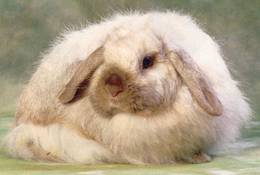
Bred from the Holland Lop and the Angora , the American Fuzzy Lop is available in a variety of colors and patterns and typically weighs less than 5 pounds. Most are very calm and easy to handle, especially for young children.
.
CALIFORNIAN
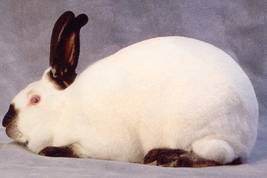
This breed was developed in the United States in the 1920’s, a mix of the New Zealand White, the Himalayan and the Standard Chinchilla. The Californian’s black nose, ears, feet and tail contrast with its snow-white body. Its plump and firm figure weighs about 8 to 10 pounds. Although it is a gentle breed, it is too large for most children to handle properly.
.
DUTCH
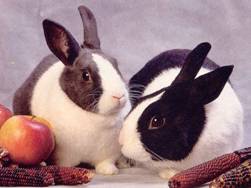
Developed in Holland, the Dutch breed is one of the oldest fancy breeds, arriving in the United States in 1864. A white section that travels vertically down the face, a white middle, white front paws and half-white back paws, defines its distinctive color pattern. The rest of the body, face and ears are either solid black, gray, steel, blue, dark brown or tortoiseshell. The Dutch rabbit is a gentle breed with excellent temperament. They generally weigh from 3 ½ to 5 ½ pounds and make great pets for children and adults.
.
ENGLISH ANGORA
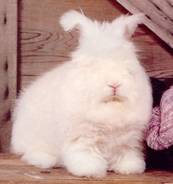
The English Angora is one of four types of Angora , which also includes the French, Satin and Giant. The compact English Angora weighs 5 to 7 pounds and can be found in more than 30 color combinations.
.
FRENCH LOP
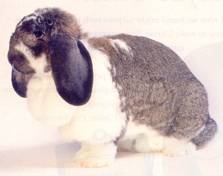
This rabbit has been bred for more than 200 years as both pet and a show rabbit. Mini Lops are a sturdy, healthy and durable animal. This breed can weigh 10 to 12 pounds.
.
HOLLAND LOP
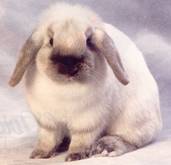
The Holland Lop is known as the Dwarf Lop, weighing in at 4 pounds. Its small size, friendly nature and inquisitive behavior make it a good choice for the first-time rabbit owner.
.
JERSEY WOOLY
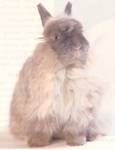
The Jersey Wooly comes in a variety of colors and weighs about 3 pounds, making it a good pet for children or for those with limited space. The Jersey Wooly has a wonderful personality that is very laid back. They just love attention. They are very well known for having gentle dispositions.
.
MINI LOP
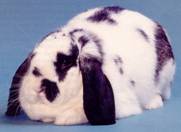
The Mini Lop weighs about 5 pounds and comes in just about any common rabbit color. They are generally very hardy and can adapt well to many situations. They all have their different personalities.
.
MINI REX
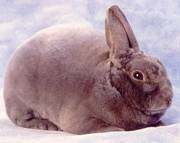
The personality of the Mini Rex is very docile. They weigh between 3 and 5 pounds and come in 14 varieties. The Mini Rex is known for their plush, velvet-like fur.
.
NETHERLAND DWARF
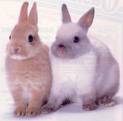
As the smallest breed of rabbit, the average Netherland Dwarf weighs about 2 pounds when fully grown. . |











